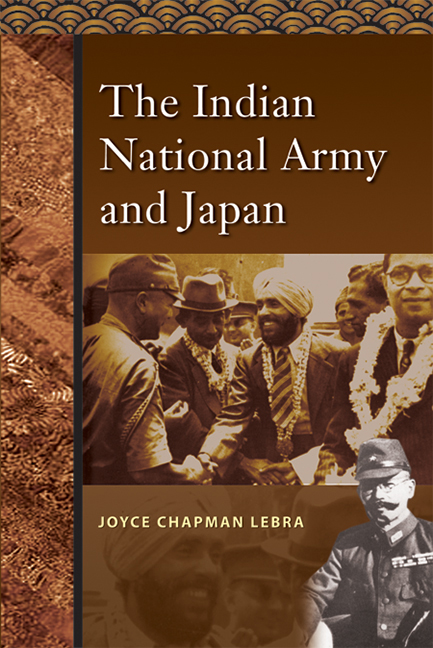Book contents
- Frontmatter
- Contents
- Illustrations and Maps
- Abstract
- Foreword
- Preface
- Acknowledgements
- Introduction
- 1 Mission to Bangkok
- 2 Malayan Jungle Meeting
- 3 Singapore Capitulates and the INA Blossoms
- 4 Tokyo Conference
- 5 Japanese Policy toward India
- 6 The Crisis of the First INA
- 7 Subhas Chandra Bose, Hitler, and Tōjō
- 8 Bose, the FIPG, and the Hikari Kikan
- 9 To India or Not?
- 10 The Rising Sun Unfurls; the Tiger Springs
- 11 A Plane Crash
- 12 A Trial in the Red Fort
- 13 Retrospect
- Notes
- Bibliographical Note
- Bibliography
- Index
- About the Author
- Frontmatter
- Contents
- Illustrations and Maps
- Abstract
- Foreword
- Preface
- Acknowledgements
- Introduction
- 1 Mission to Bangkok
- 2 Malayan Jungle Meeting
- 3 Singapore Capitulates and the INA Blossoms
- 4 Tokyo Conference
- 5 Japanese Policy toward India
- 6 The Crisis of the First INA
- 7 Subhas Chandra Bose, Hitler, and Tōjō
- 8 Bose, the FIPG, and the Hikari Kikan
- 9 To India or Not?
- 10 The Rising Sun Unfurls; the Tiger Springs
- 11 A Plane Crash
- 12 A Trial in the Red Fort
- 13 Retrospect
- Notes
- Bibliographical Note
- Bibliography
- Index
- About the Author
Summary
For over two decades following the end of World War II, Japan's goals and tactics in wartime Greater East Asia have remained buried in government and military archives and in the memories of wartime leaders still living. The image, fostered through the proceedings of the International Military Tribunal in Tokyo, of Japan as one of the world's most rapacious militarist powers has long prevailed on both sides of the Pacific. Difficulty of access to private and official archives of the war years has helped perpetuate the darkness which still obfuscates many aspects of the Pacific War. Japanese historians still remain reluctant to scrutinize the concepts, goals, and implementation of Japan's Greater East Asia Co-Prosperity Sphere in Asia.
American scholars have only recently pioneered in re-examining Japan's war aims and have begun the work of revising earlier assumptions. This task has been facilitated by the appearance of the first volumes of the Japanese official history of World War II, edited by the staff of the War History Office of the Defence Agency.
The war, according to some American revisionists, was not simply a Japanese version of the capitalist pattern of imperialism described by Lenin and demonstrated by Western powers. It was more significantly a war for preservation and defence of vital interests threatened by the advance of Western imperialism in Asia. Similarly, the traditional image of the Greater East Asia Co-Prosperity Sphere as the grand design for Japanese empire in Asia can also be questioned. For one thing, the borders of the Greater East Asia Co- Prosperity Sphere were nebulous and elastic. The concept crystallized in the minds of various individuals, some civilian but mostly military, by late 1940. But the forerunners of the Sphere—the East Asia Co-operative Body and the New Order in East Asia—were advanced even earlier, during the Manchurian Incident. For some, by early 1941, the Greater Sphere, or sphere of influence, would sweep across Asia to embrace India, Australia and New Zealand within its compass. The goal of economic self-sufficiency provided the rationale for political and cultural arrangements. The concept of the Sphere grew as more of Southeast Asia fell under Japanese military occupation.
- Type
- Chapter
- Information
- The Indian National Army and Japan , pp. xiii - xviPublisher: ISEAS–Yusof Ishak InstitutePrint publication year: 2008



